Robert Lewandowski has enjoyed an outstanding career in the Bundesliga at both Bayern Munich and Borussia Dortmund. In his ten years in the league, Lewandowski has scored 232 goals, winning the Bundesliga twice with Dortmund and five (likely soon to be six) times with Bayern.
Despite being 31-years-old, Lewandowski has continued to score, seemingly at will, for Bayern Munich. This tactical analysis will examine how Lewandowski continues to be so potent for the Bavarian club. In this scout report, the analysis will look at how he fits into Hansi Flick’s tactics, as well as his movement and patience in the penalty area.
Player overview
While Lewandowski’s position is listed as a centre-forward, he is certainly not bound by the traditional expectations of that role.
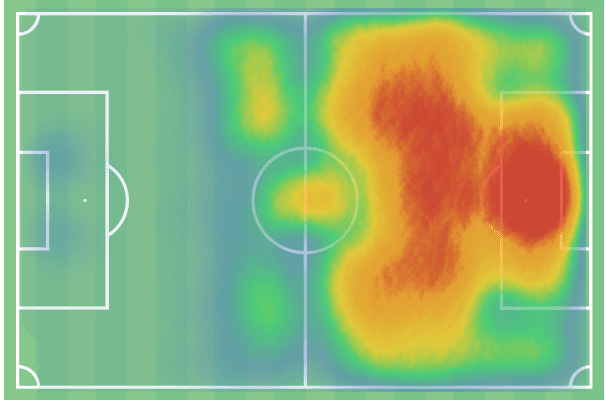
As is evident in his heat map, Lewandowski is allowed to roam and drift around the attacking half. What’s important to understand is that Lewandowski’s role within Bayern’s system is fluid because of so many of the positional play principles that have been implemented in the squad. The positional rotations Bayern utilise allow for maximum flexibility within the squad, and Lewandowski’s flexibility will be highlighted shortly.
This season, Lewandowski is averaging an astounding 0.9 goals per 90 minutes played with an equally astounding 0.75 xG per 90. Considering he is averaging only 3.83 shots per 90 minutes played, he is seemingly able to get into scoring areas that have a higher success rate. Unsurprisingly, at the time of writing, 29 of his 30 goals have come from inside the penalty area (almost always from a central area), with the exception being a free kick against Schalke back in August. While his goals come from a consistent area, the way in which he arrives in the space varies, and that’s due to Lewandowski’s positional flexibility.
Positional flexibility
As shown on the heatmap above, one of Lewandowski’s strengths is his ability to operate all throughout Bayern’s attack and not just solely as a centre-forward who tries to pin the opponents’ two centre-backs. The system that has been created at Bayern, particularly under Hansi Flick, has allowed for very fluid rotations between all players, which leads to more men receiving the ball with more time and more space, ultimately resulting in headaches for opponents. On top of his typical role as a centre-forward, Lewandowski also consistently drops into the midfield as well as outside on the flanks.
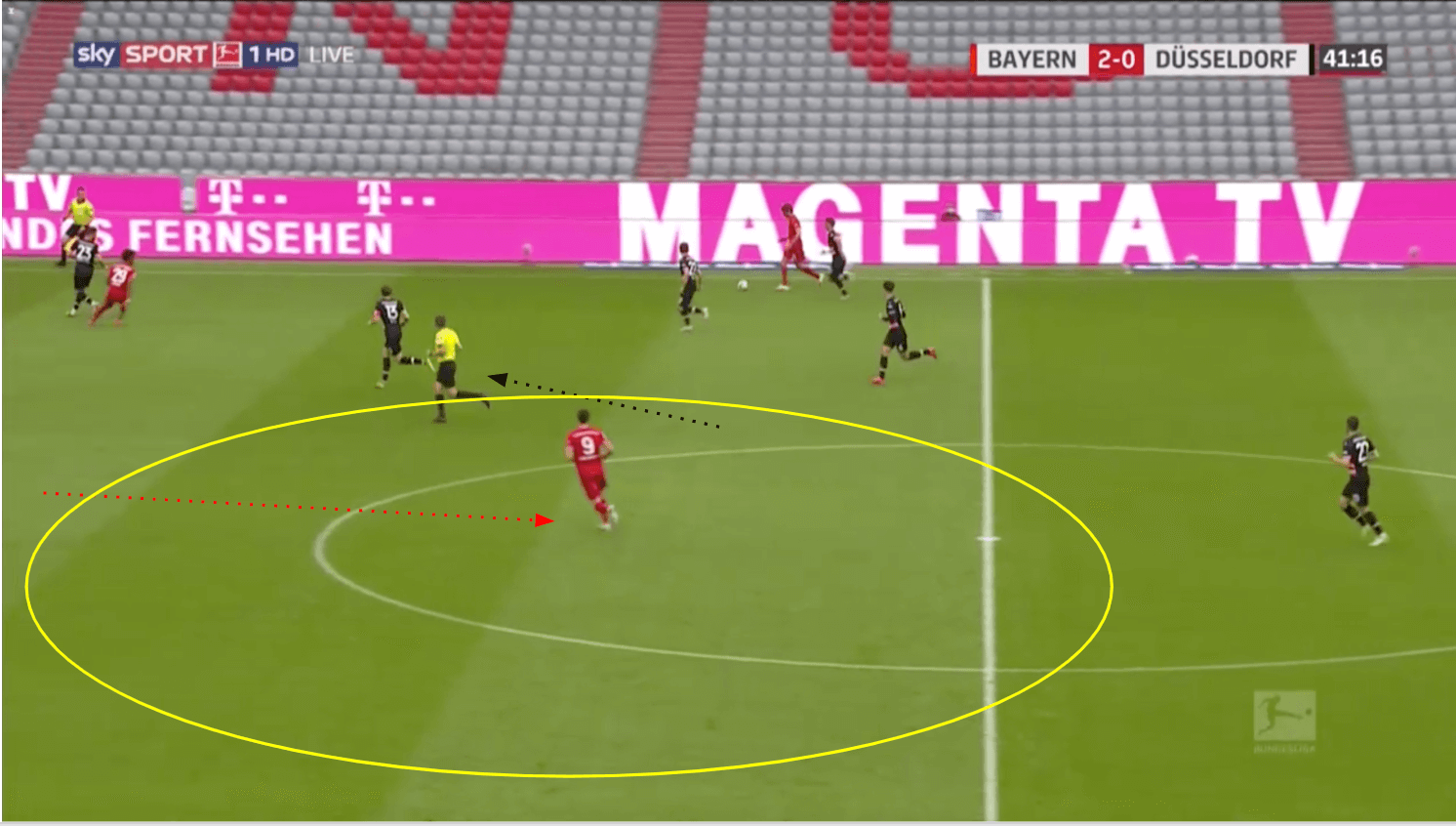
Sometimes Lewandowski will drop in order to help with the build-up; other times he’ll drop down into the midfield or half-space in order to create a numerical advantage, overwhelming opponents in the process. In the image above, Bayern were in the midst of their build-up. All three of their midfielders had dropped, and so Lewandowski was able to find space as Düsseldorf pressed them on the wings. Thomas Müller was unable to find Lewandowski with his pass, but the centre-forward would have been able to dribble at the centre-backs with the support of Kingsley Coman and Serge Gnabry wide on both of the wings.
Lewandowski himself frequently ends up on either the left or right flank throughout the match, depending on how Bayern’s midfielders and wingers have rotated.
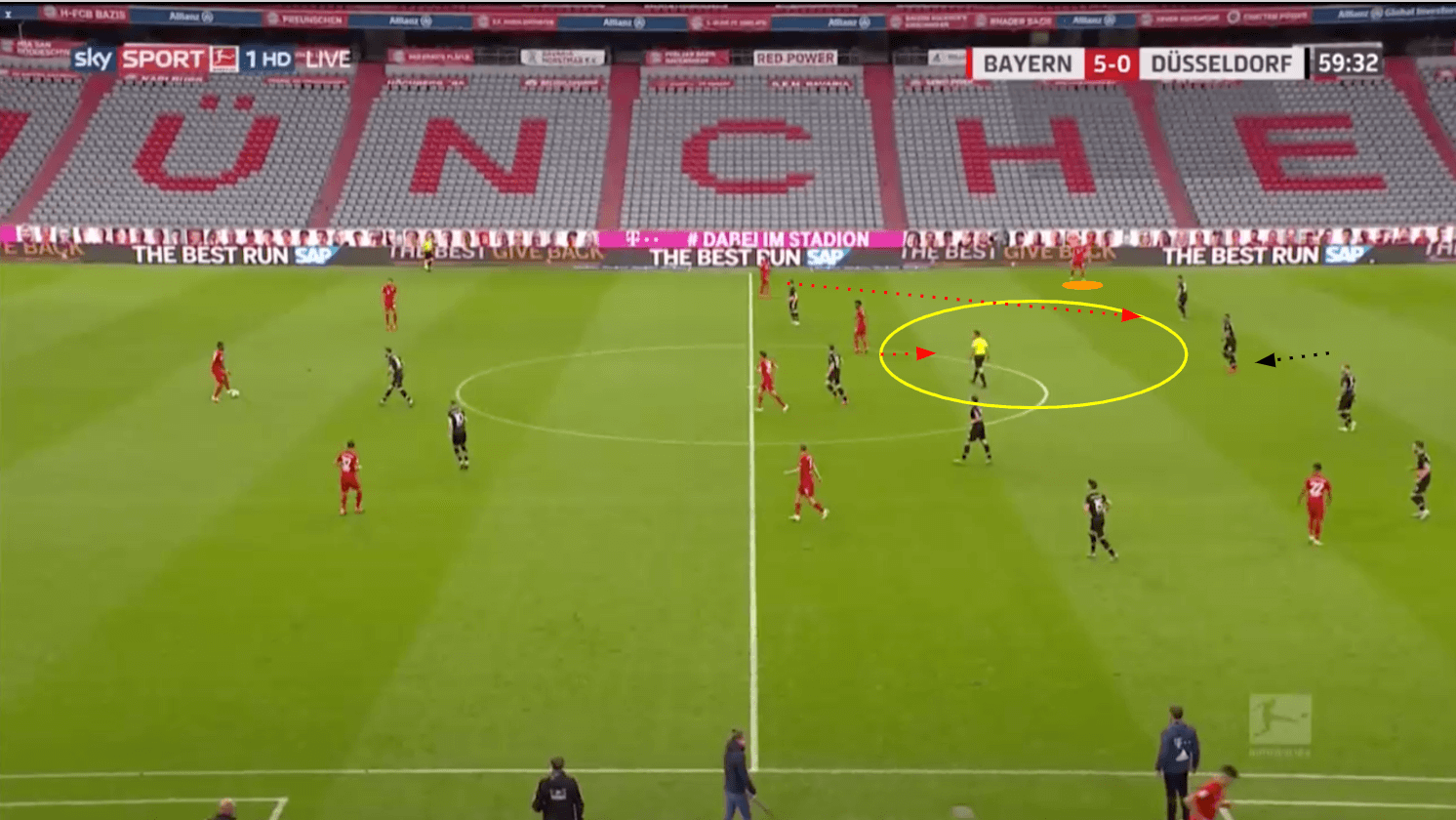
Lewandowski will occupy either flank, and when he does, he creates a numerical advantage for Bayern as they look to attack. In the image above, Lewandowski, marked in orange, is as far wide as he can be. This positioning alone impacts the game because now Düsseldorf’s centre-backs have no one to mark, making them susceptible to push higher (as the right centre-back is), creating more opportunities to exploit the space in behind. Because of Lewandowski’s wide position, Coman can now operate freely in the half-space, with plenty of room for him to turn and attack. In this case, Coman wasn’t an option, so the ball was played to Lewandowski, who was underlapped by Alphonso Davies. Düsseldorf’s right-back was forced to stay put and mark Davies, allowing Lewandowski to dribble forward and ultimately play a pass to Davies. In other cases, Lewandowski has been able to dribble, create space, and deliver a cross to a teammates head in the centre of the penalty area as well.
What makes his (and Bayern’s) positional flexibility so dangerous is that any back line needs to constantly be tracking all of Bayern’s attackers at any point. Any instance of them not doing so properly can be devastating, as Lewandowski demonstrated against Düsseldorf.
Lewandowski started the move with a deft first touch that saw his pass play Joshua Kimmich in behind the defensive line.
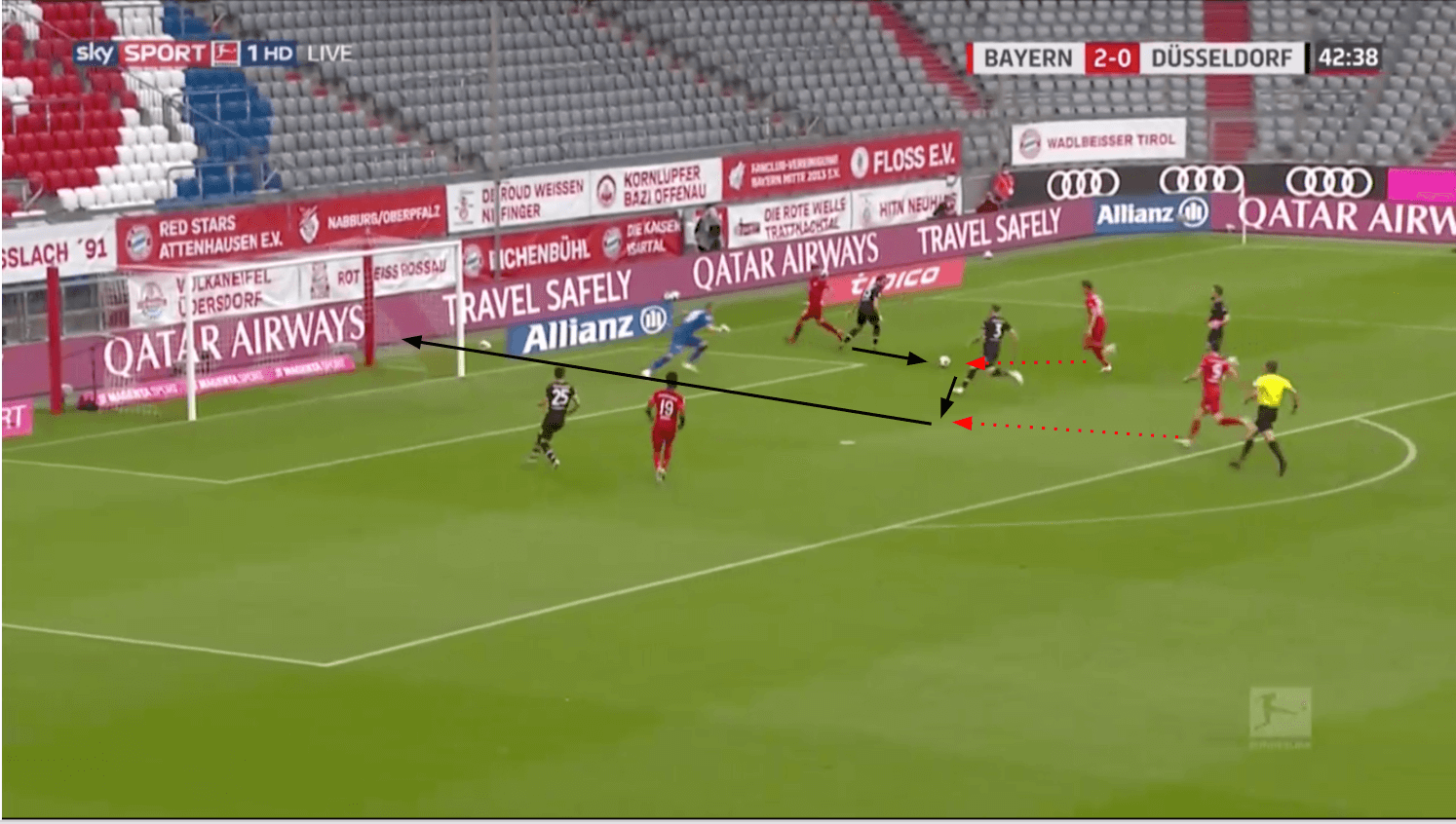
As Kimmich dribbled at the goalkeeper, Lewandowski turned and ran down the centre of the pitch towards the penalty area. Kimmich laid the ball off to Müller, who used his first touch to play Lewandowski, who was patiently waiting behind the play. Lewandowski’s positional fluidity and ability to read the game allowed him to be in the position to score Bayern’s third goal of the match.
Similarly, Lewandowski was able to attack from his position on the wing against Düsseldorf. After receiving the ball in the half-space, Lewandowski played Benjamin Pavard on the wing and offered his support positionally.
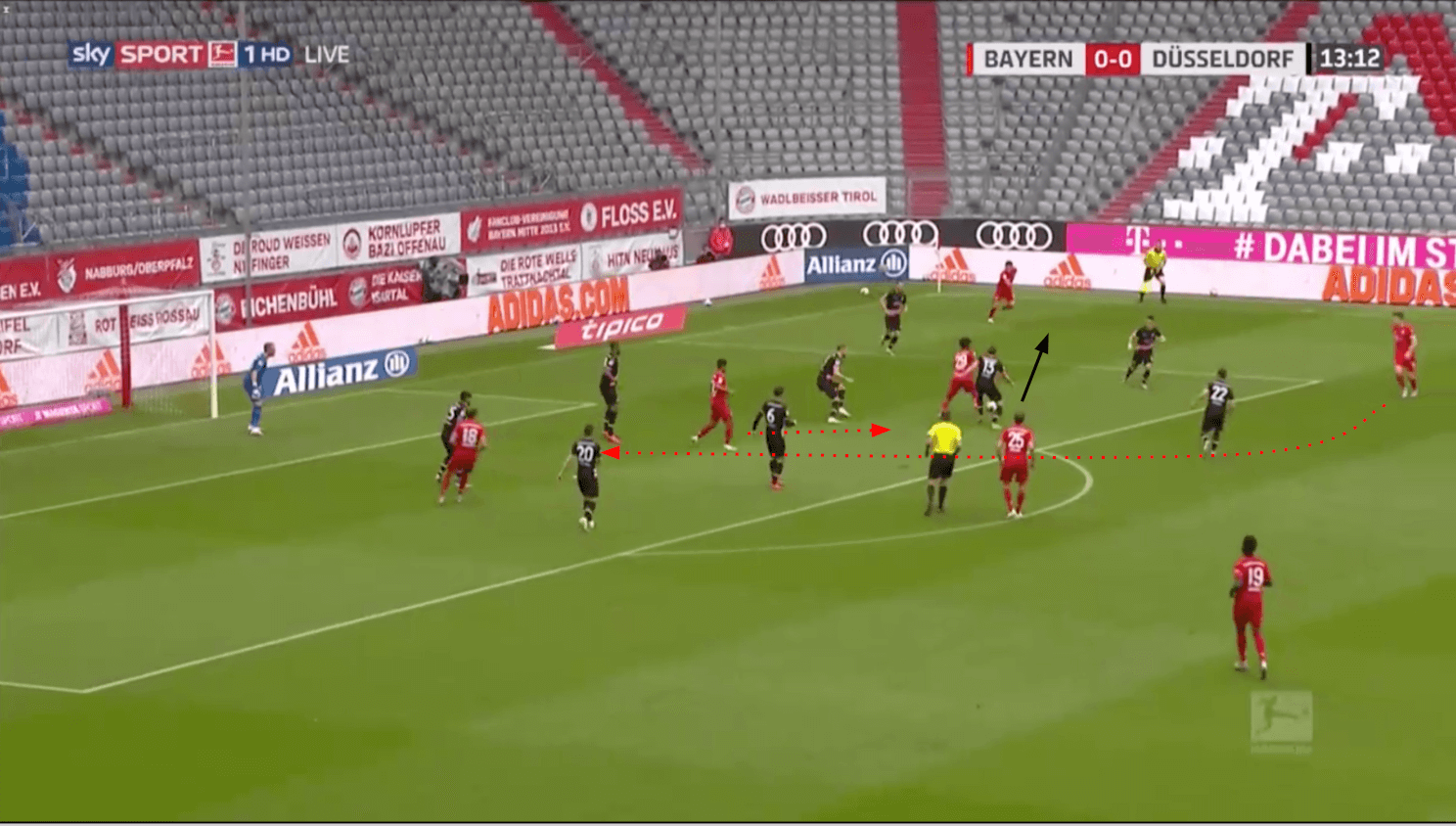
Pavard made a wall pass to Coman, which is when Lewandowski began his run from outside the penalty area. As Coman was playing the ball back to Pavard, Lewandowski curved his run, appearing directly in front of the Düsseldorf centre-back as the ball arrived, albeit just above Lewandowski’s head. None of the Düsseldorf defenders were able to pick up his run, despite being in a position to do so, and this was because his constant movement and positional fluidity caused confusion as to who was responsible for marking him. While this attempt didn’t end in a goal, a very similar run against Borussia Dortmund in November ended with him burying the opportunity.
Movement in and around the box
While Lewandowski is certainly willing and able to support his team in possession by dropping into areas that are less-frequented by centre-forwards, his biggest contributions to Bayern’s performance come both in and around the penalty area. His ability to play in these tight spaces and create enough room for himself are what allow him to be such a potent goalscorer.
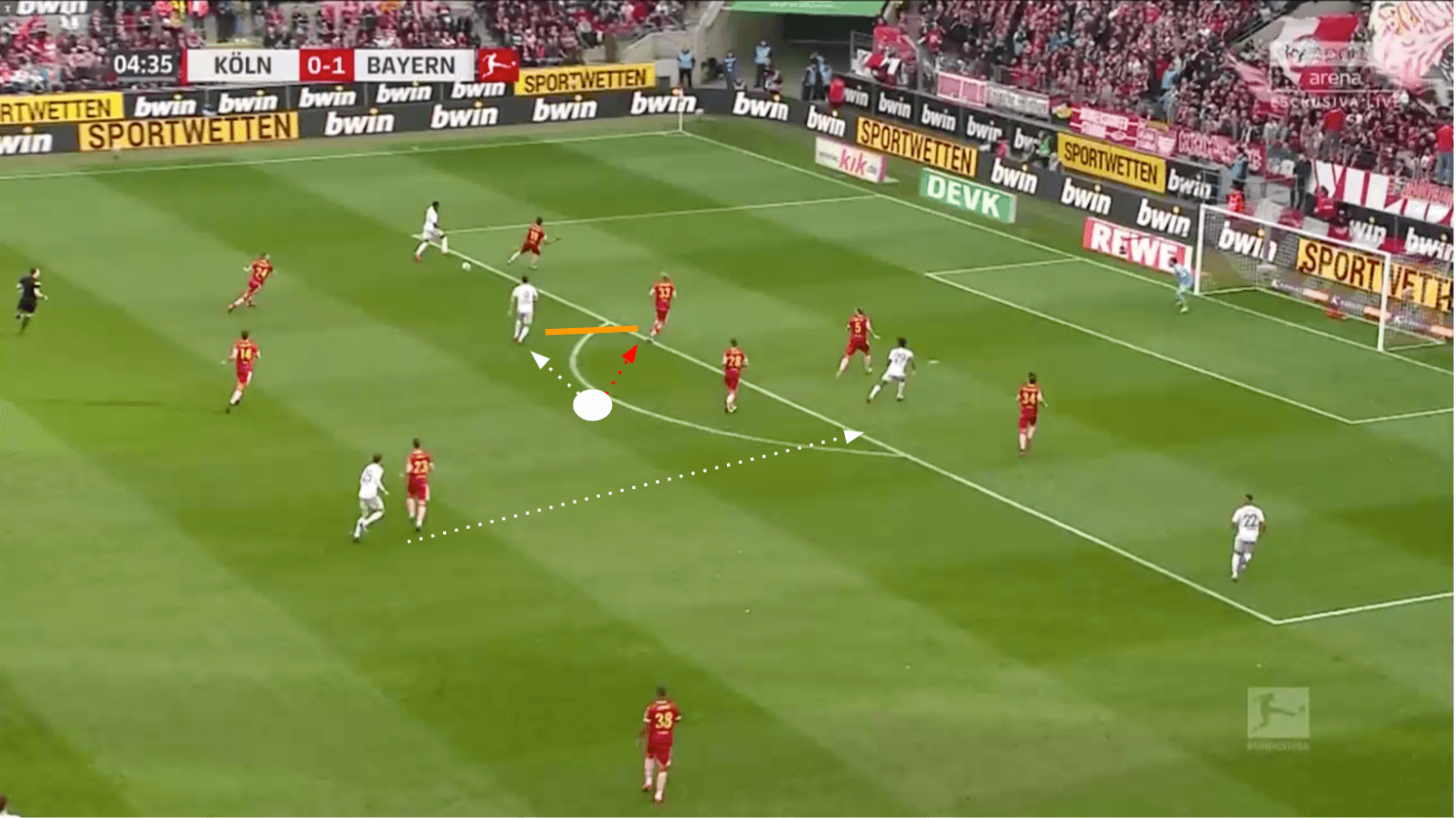
In the build-up to their second goal against FC Köln, Lewandowski was able to create space between him and his defender. As the ball went from the midfield to the left flank to Alphonso Davies, Lewandowski’s defender continued to drop with the rest of his defensive line. Lewandowski didn’t go forward with the defender; instead, he drifted towards Davies, who used his first touch to play the ball to Lewandowski. The distance between Lewandowski and the defender, highlighted in orange, allowed him enough time to turn, take three touches, and then lay the ball off to Müller, whose first touch found Coman wide open in front of goal. This entire opportunity was created because Lewandowski created enough room for himself to receive the ball and turn in a dangerous area.
Another way in which he creates space is by moving the opposite way of the direction of the ball. This means that when the ball is played to the left, Lewandowski moves towards the right. This can be incredibly dangerous in the box because an attacker doesn’t need large amounts of space to finish off a chance. One example of him doing this came against Köln.
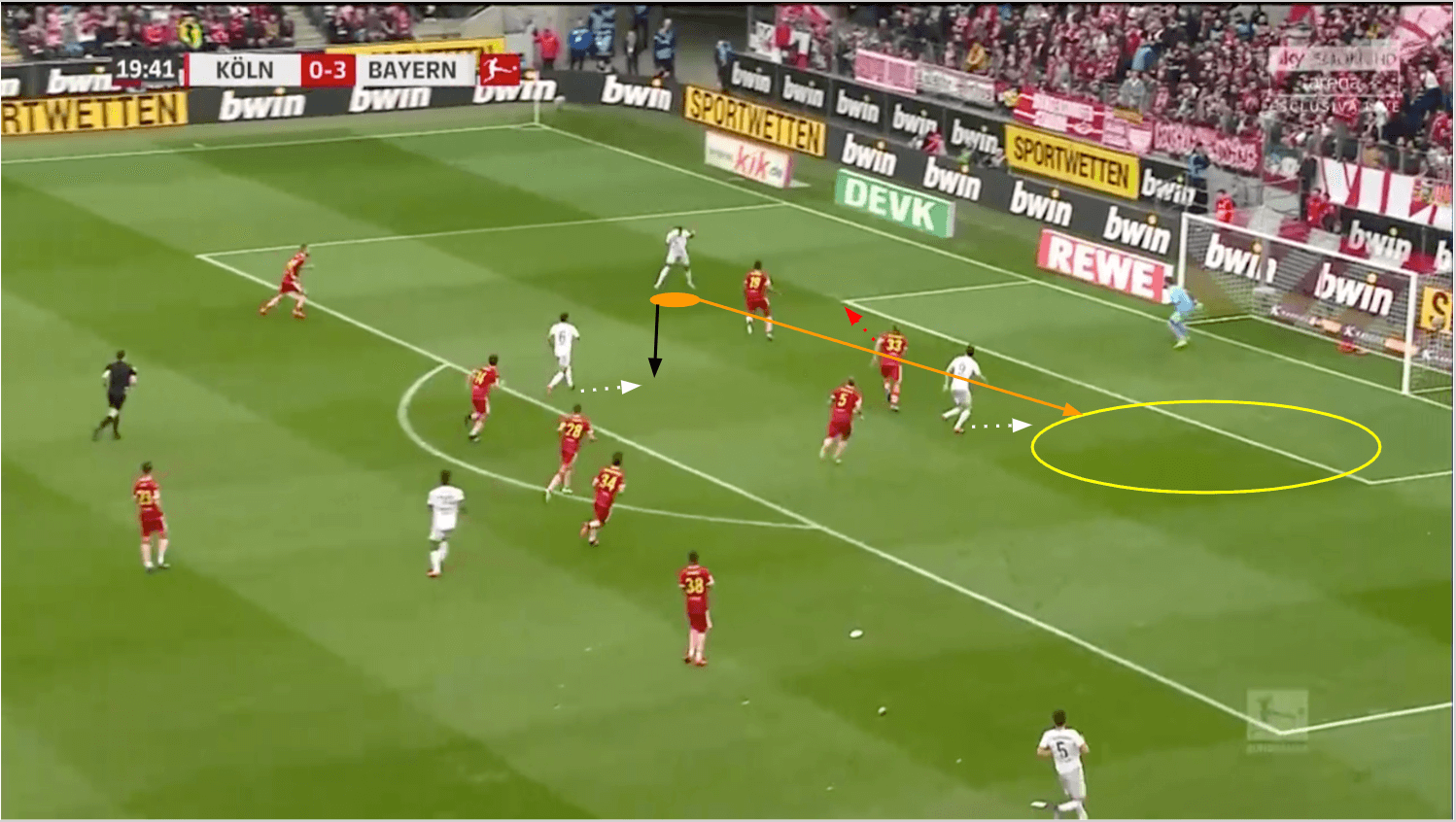
As the ball went from the middle of the pitch to the left side of the penalty area, the Köln defenders shifted slightly to be closer to the ball-side. As they did, Lewandowski went the opposite direction, opening up lots of room for him to finish any chance sent his way. If Gnabry, marked with the orange circle, had chosen the pass in orange, Lewandowski would have certainly scored as he was left wide-open on the back post. Instead, Gnabry opted for Thiago, likely because the ball was in the air, and it would have been difficult to properly play it to Lewandowski with enough pace.
Lewandowski also uses his movement in the box in order to create space for teammates. In the image below, Lewandowski’s head is turned, as he takes into account the situation. Not pictured to the left of him is Joshua Zirkzee.
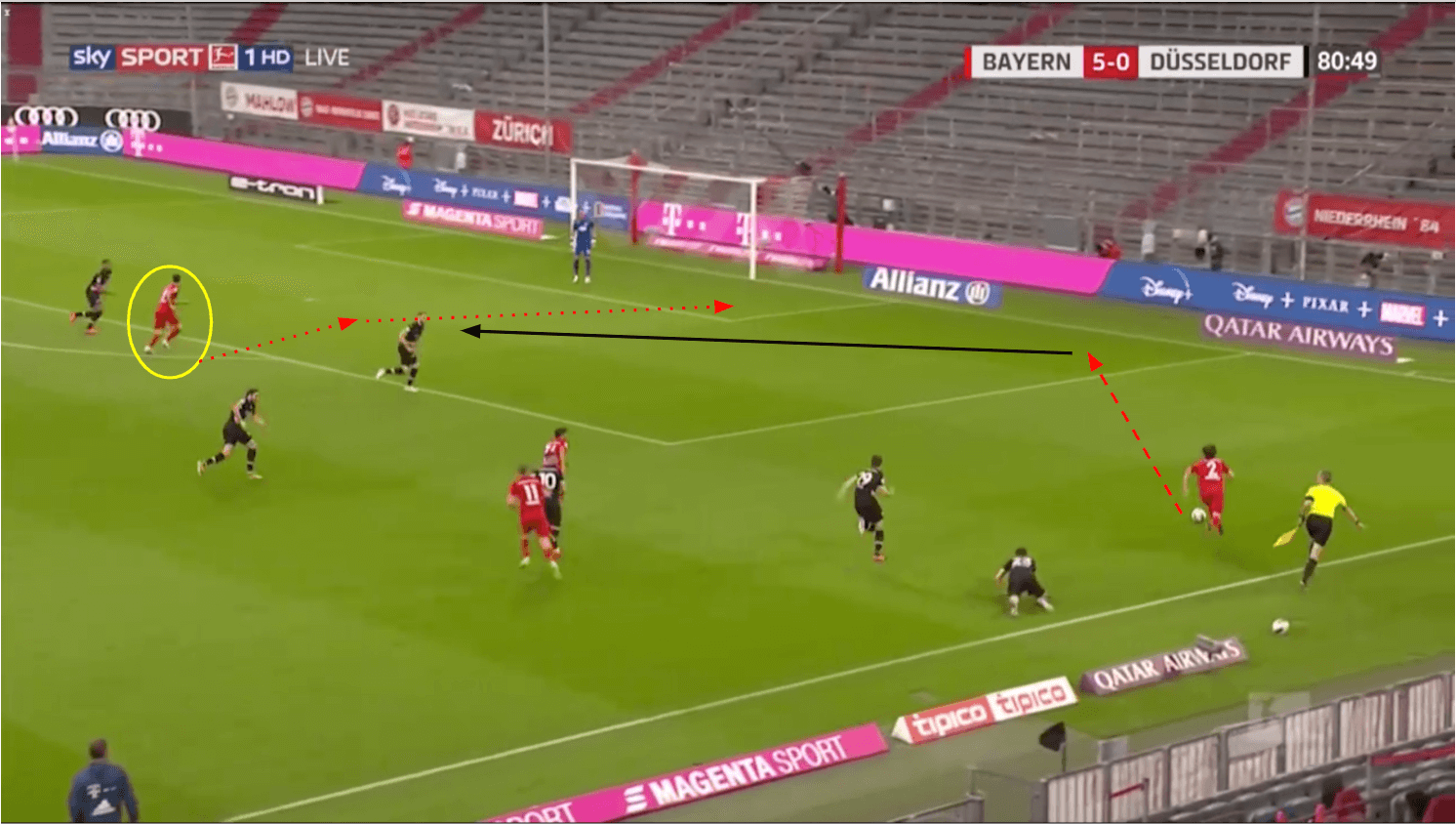
As Alvaro Odriozola dribbled toward the endline, Lewandowski made his run to the near post, attempting to drag his defender with him. This would create space behind Lewandowski that Zirkzee could attack. If the defender didn’t follow him, Lewandowski would be wide open on the near post. Luckily for Düsseldorf, Odriozola didn’t read the situation properly and tried to force a pass into Zirkzee, when in reality, the near-post was the best option, as the defender bizarrely chose not to mark Lewandowski.
The final note to make in terms of Lewandowski’s movement within the penalty area is his use of space directly behind a defender. Lewandowski often positions himself directly behind the defender, meaning the defender cannot see him. He will know Lewandowski is behind him, but not where exactly, which allows for Lewandowski to make one quick move, and he’s open and in behind with ease.
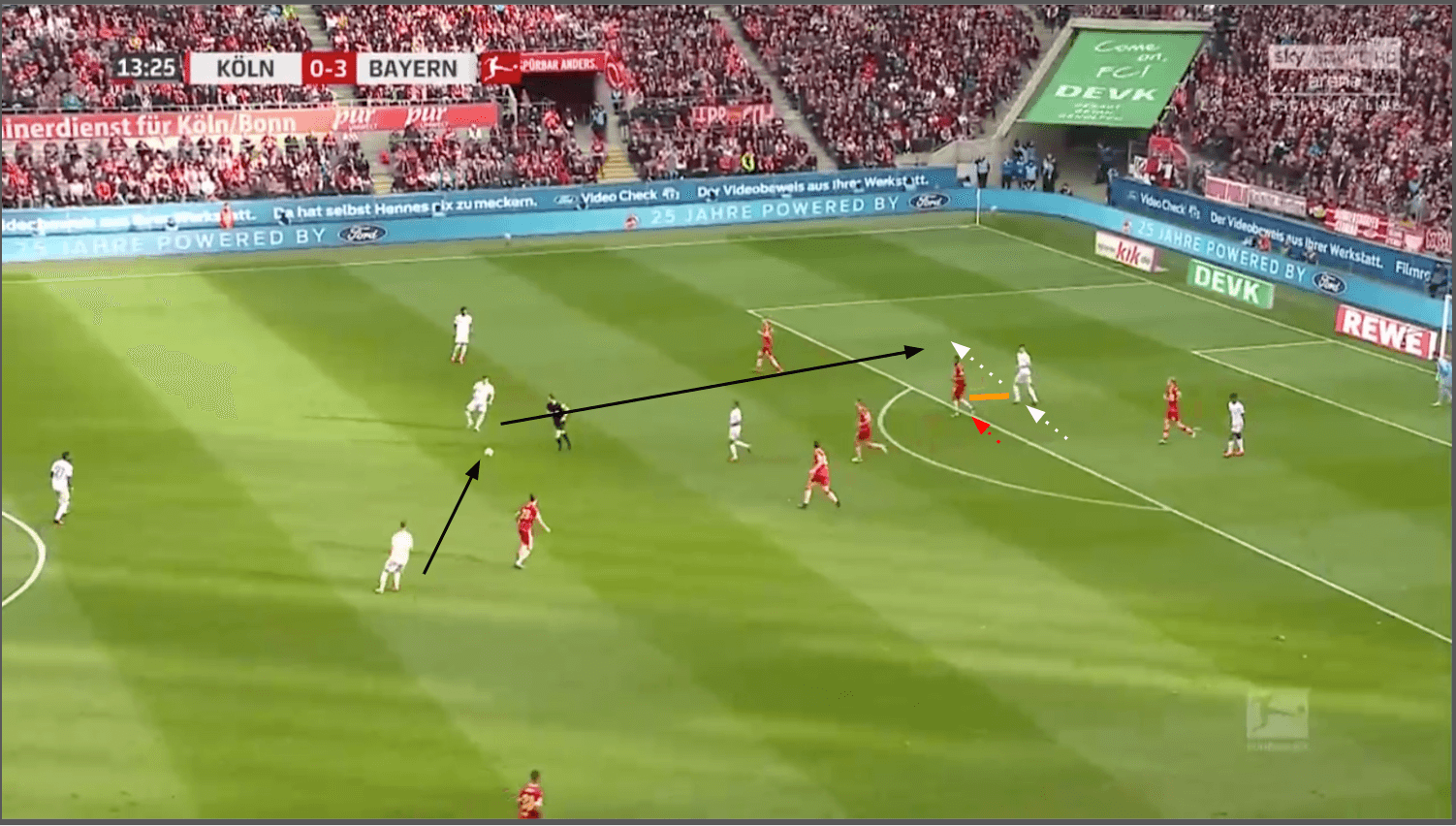
Against Köln, Lewandowski demonstrated this exact skill when Bayern were in possession. As the ball made its way from the right half-space to the left half-space, Lewandowski remained behind his defender, shadowing his movements. In the image above, he’s actively checking his shoulder to ensure he’s still onside. As soon as the ball arrived at Gnabry’s foot, Lewandowski accelerated into the space and received the ball with an open body profile. He then used his first touch to create more space for a shot, which ultimately ended up just wide of the goal. Lewandowski does this in other situations as well, finding space behind defenders when their line isn’t organised deep in their own defensive third or coming out from behind a defender to receive a pass when Bayern are looking to counterattack. This constant intelligent movement makes him a nightmare to defend and helps explain his goal scoring record.
Arriving in space at the proper time
The last large part of Lewandowski’s goal-scoring success comes from his ability to recognise space and exercise patience in exploiting it. One of the things he almost certainly developed during his time at Bayern is the ability to arrive in space at the perfect moment. Lewandowski’s ability to do so creates chance after chance, which he clearly has a knack for finishing off.
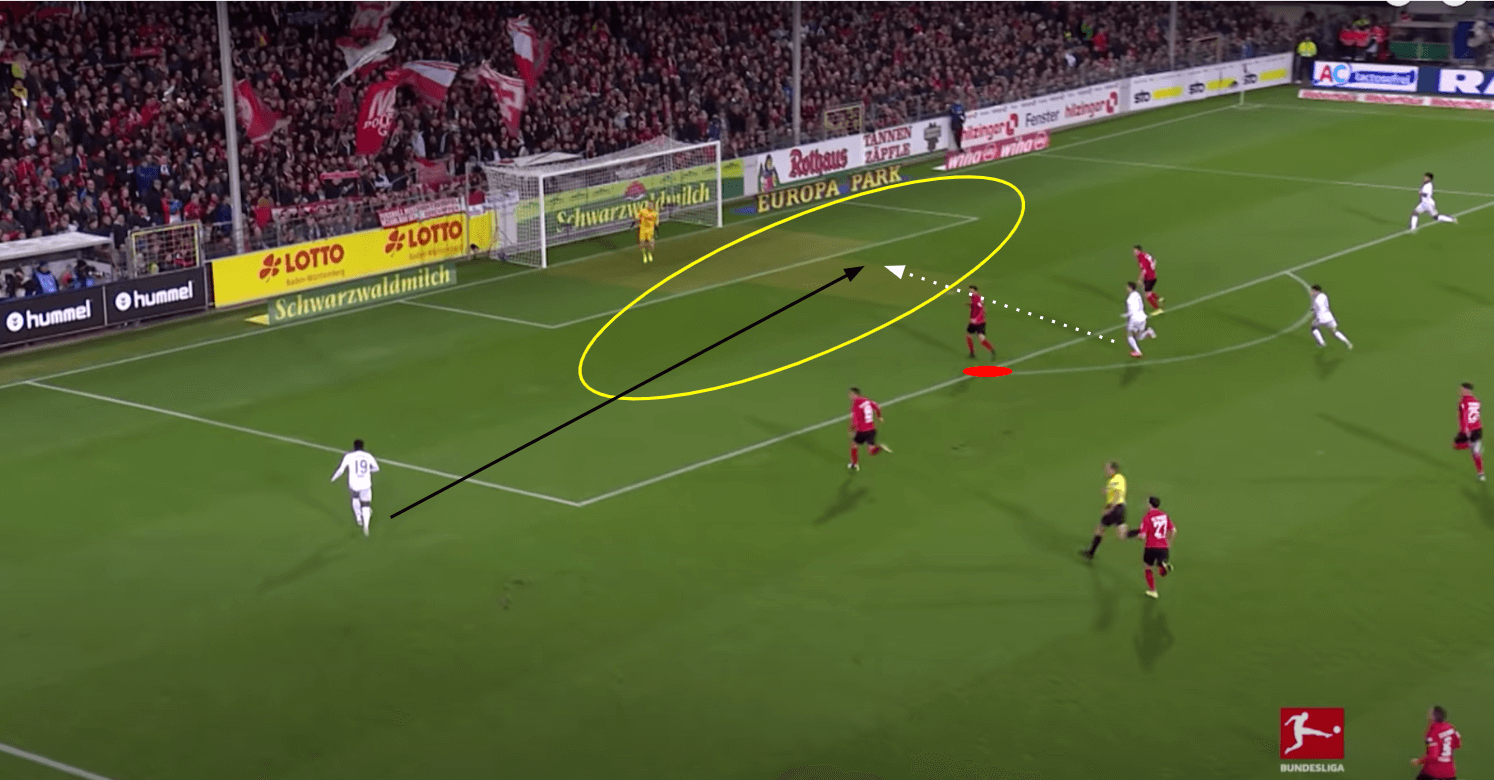
In the image above, Lewandowski combined his recognition of space with his patience in order to arrive at the perfect time. Alphonso Davies had made a marauding run up the left side of the pitch. With lots of time and space available, Davies had to wait for Lewandowski’s move. What happened was simple: the centre-back marked in red checked his shoulder to see where Lewandowski was. As soon as he turned his head back to look at Davies, Lewandowski attacked the available space. Davies drilled a pass across the face of goal, and Lewandowski arrived at the perfect time to bury the chance in the back of the net. The front centre-back was unaware of Lewandowski’s run, and the back centre-back was not quick enough to react. If the run was made any earlier, it would have easily been shut down by the first centre-back. Lewandowski’s ability to wait for the perfect moment allowed him to arrive in that space at exactly the right time.
Lewandowski’s ability to arrive in the right space at the right time was also on display against Schalke in August. Kingsley Coman was in possession in the final third, looking to fizz a ball across the back line of the defence.
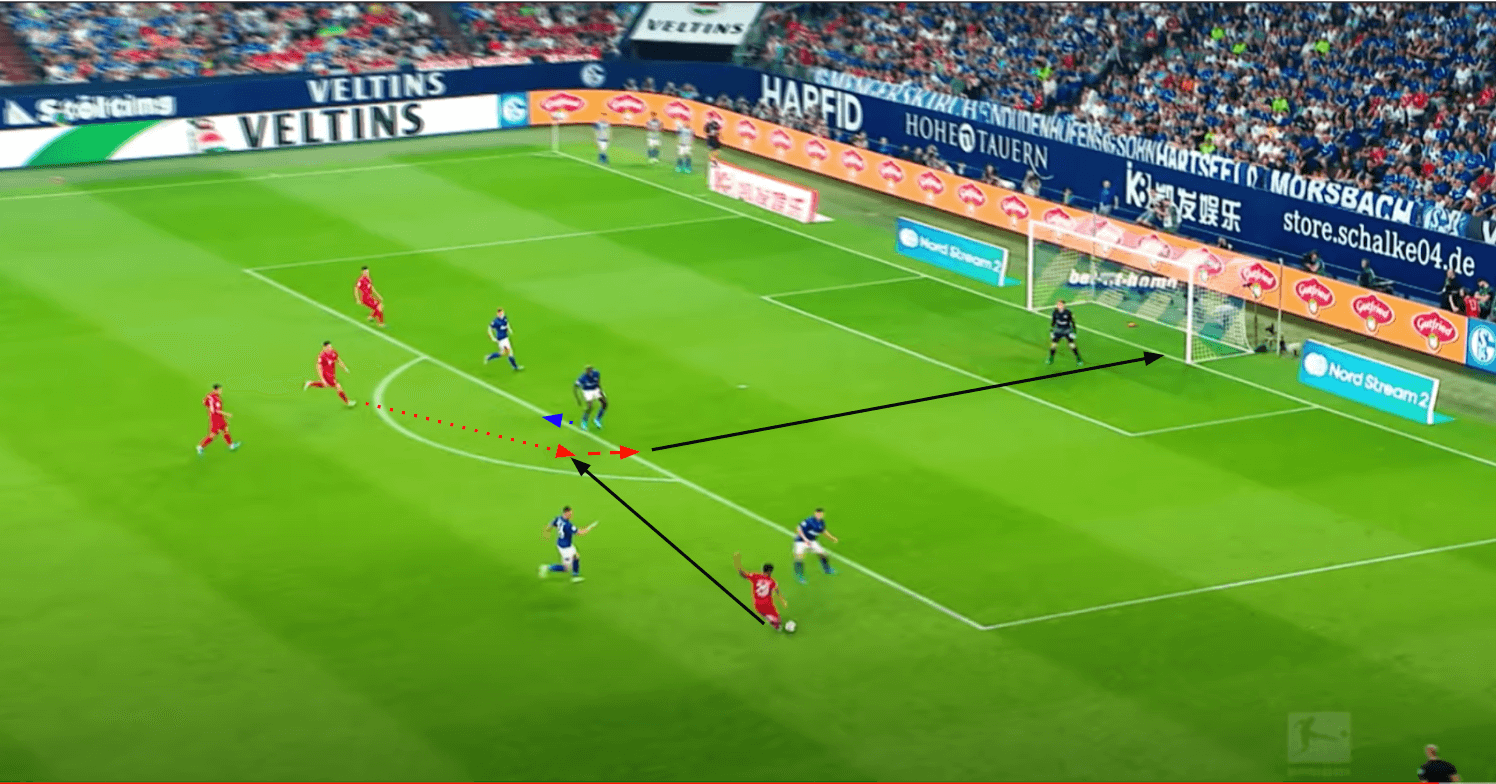
Normally, horizontal passes are discouraged because they often end up intercepted. However, with the pace Coman put on the ball combined with Lewandowski’s arrival, this was an instance of a horizontal pass being acceptable. As Coman’s pass went from right to left, so did Schalke’s defensive line. Lewandowski came from the centre of the pitch to the right side, again going the opposite direction of the pass. This meant his closest defender was going the opposite direction of him, which allowed him to receive the ball, take a touch, and then fire it into the back of the net. The timing of the arrival is what makes this goal happen: if he arrived too early, he’s easily defended by the centre-back; too late, and the centre-back would have intercepted the pass without much problem.
Finally, Lewandowski’s ability to arrive at the perfect time was on display against Paderborn earlier in the season.
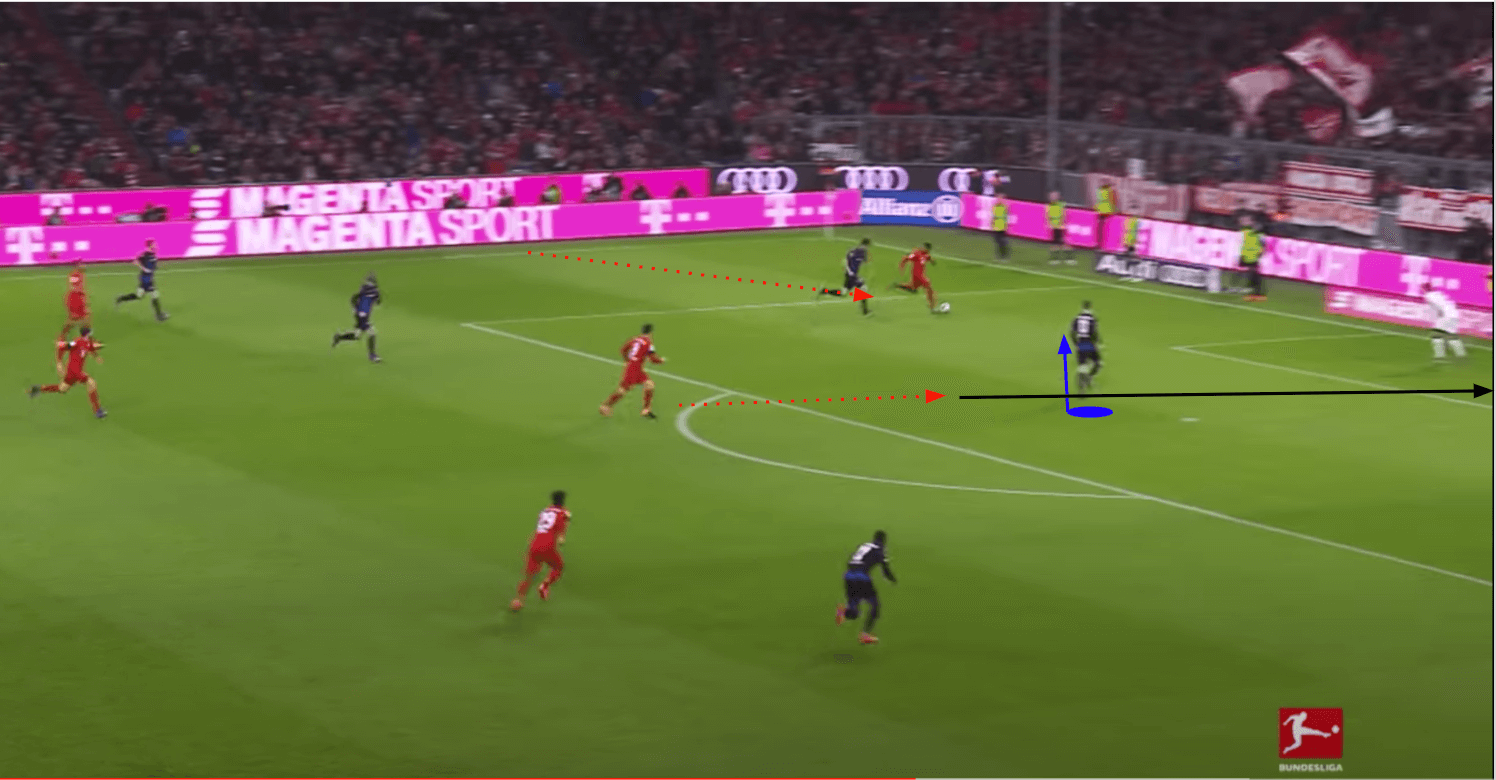
As Gnabry dribbled into the area of the pitch where so many assists come from in modern football, Lewandowski was watching Paderborn’s centre-back. If Lewandowski rushed his run, the centre-back could effectively prevent him from receiving the ball while also pressuring Gnabry. Instead, Lewandowski delayed his run, jogging forward slowly until the centre-back had no choice but to pressure Gnabry. At this point, all Lewandowski needed to do was step into a passing lane at the penalty spot. Gnabry laid the ball off, and Lewandowski put it in the back of the net.
Conclusion
Lewandowski’s consistency has made him a huge part of Bayern Munich’s success over the last six years. His relationship with the club has certainly been mutually beneficial: the club have won the league every year since he joined Bayern in July 2014. He has been the top scorer in the league four (soon to be five) times, so it’s not too surprising that Bayern’s success has mirrored his, considering the majority of his scoring titles occurred at Bayern. While he has never won the UEFA Champions League, Bayern certainly have an opportunity to do so when the competition resumes, assuming they can maintain their momentum that they’ve built throughout their season so far. There’s no telling how much longer Lewandowski can continue scoring and contributing to Bayern’s attack at this current rate, so it’s best to enjoy it while he still does.





Comments